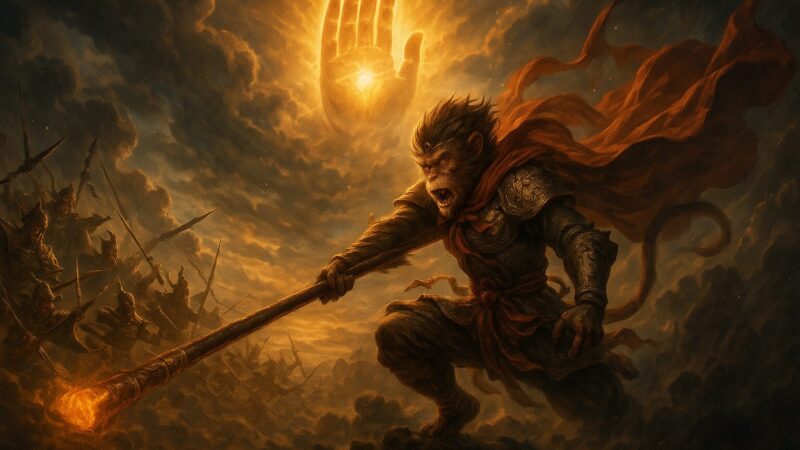Sun Wukong: The Epic Legend of the Monkey King’s Journey from Rebellion to Enlightenment
2025.11.25更新
【PR】

The legend of Sun Wukong, the Monkey King, tells the story of a stone-born trickster who became an enlightened protector in Journey to the West. His journey blends mythology, rebellion, discipline, and wisdom.
Introduction
Sun Wukong, widely known as the Monkey King, is one of the most iconic figures in Chinese mythology.
The epic tale of Sun Wukong, preserved in the 16th-century novel Journey to the West, tells how a mischievous monkey challenged heaven, defied gods, and eventually achieved enlightenment through discipline.
This article explores the full legend of Sun Wukong—from rebellion against heaven to his transformation into a symbol of wisdom and loyalty—while highlighting the cultural significance and global legacy of his story.
Origins: The Birth of Sun Wukong from Stone
On the Mountain of Flowers and Fruit, a mystical stone absorbed the essence of the cosmos.
From it emerged Sun Wukong, a monkey unlike any other—curious, ambitious, and restless.
He led his fellow monkeys with courage but soon longed for more. His ultimate goal was immortality.
Sun Wukong’s Training in Taoist Arts
Seeking eternal life, Sun Wukong studied under a Taoist master.
There he mastered:
- Seventy-Two Transformations: the power to shapeshift into animals, objects, or even mist.
- Cloud Somersault: leaping vast distances in a single bound.
- Ruyi Jingu Bang: a magical iron staff, gifted from the Dragon King, that could shrink or expand at will.
With these skills and weapons, Sun Wukong grew strong enough to defy the heavens.
Rebellion Against Heaven
The Jade Emperor attempted to tame Sun Wukong with minor celestial titles.
But when Sun Wukong discovered his role was little more than a stable hand for divine horses, his anger boiled over.
Declaring himself “Great Sage Equal to Heaven”, Sun Wukong fought the celestial armies, stole the peaches of immortality, and consumed the pills of eternal life.
Not even the gods could control him.
The Buddha’s Trap
At last, the Buddha challenged Sun Wukong.
If he could leap beyond the Buddha’s palm, he would win freedom.
With his Cloud Somersault, Sun Wukong soared across the universe, marking five distant pillars in triumph.
Yet those pillars were only the Buddha’s fingers.
Defeated, Sun Wukong was sealed beneath the Five Elements Mountain for 500 years.
Journey to the West: The Path to Redemption
The Golden Circlet
When the monk Tang Sanzang began his holy journey to India, he required protectors.
The Bodhisattva Guanyin released Sun Wukong but bound him with a golden circlet.
When Tang Sanzang recited a spell, the band tightened painfully, forcing obedience.
Thus began the Monkey King’s reluctant path of discipline.
Fierce Battles and Trials
Sun Wukong faced countless demons, including:
- Bull Demon King & Family: once his sworn brother, now an enemy allied with Princess Iron Fan and their son, Red Boy.
- White Bone Demon: a cunning foe who disguised herself as innocents, testing trust between master and disciple.
- Spider Spirits and Yellow Wind Demon: enemies who tested not only his strength but also patience and cleverness.
Through eighty-one trials, Sun Wukong’s reckless defiance slowly transformed into steady loyalty.
Symbolism and Lessons of the Monkey King
The story of Sun Wukong is not only adventure—it is allegory.
- Five Elements Mountain: the weight of human flaws and desires.
- Golden Circlet: the conscience that restrains pride and anger.
- Tang Sanzang: compassion and wisdom.
- Zhu Bajie: human indulgence.
- Sha Wujing: endurance and perseverance.
Together, they form a map of the human heart, balancing rebellion with order.
Cultural Legacy Across the World
The legend of Sun Wukong resonates far beyond China.
- In Japan, his spirit lives on in Dragon Ball’s Goku.
- In Chinese opera, Sun Wukong’s painted face, acrobatics, and staff remain iconic.
- In the West, Sun Wukong is often compared to Prometheus or Loki, fellow tricksters who challenged divine order.
This universality explains why the Monkey King endures as a symbol of freedom, discipline, and transformation.
Conclusion: From Trickster to Buddha
By the end of the pilgrimage, Sun Wukong earned the title Victorious Fighting Buddha.
Once a rebel who defied the heavens, Sun Wukong became a symbol of spiritual growth and enlightenment.
His tale asks us to reflect: is true strength in breaking chains, or in mastering ourselves?
Frequently Asked Questions (FAQ)
Question: Who is Sun Wukong in Journey to the West?
Answer: Sun Wukong, or the Monkey King, is a stone-born trickster who gains immense powers, defies heaven, and later redeems himself by protecting the monk Tang Sanzang on his pilgrimage to India.
Question: What is the significance of the Ruyi Jingu Bang?
Answer: The Ruyi Jingu Bang is Sun Wukong’s magical staff. It can shrink or expand at will, symbolizing adaptability and strength. It is one of the most famous weapons in Chinese mythology.
Question: Why did the Buddha imprison Sun Wukong?
Answer: Sun Wukong’s arrogance and defiance of heaven led to chaos. The Buddha trapped him beneath the Five Elements Mountain for 500 years as punishment and reflection.
Question: How does Sun Wukong’s story influence modern culture?
Answer: His legend inspired works such as Dragon Ball in Japan, appears in Beijing opera, and has parallels with Western trickster figures like Loki and Prometheus.
Question: What lesson does the Monkey King’s journey teach?
Answer: It highlights the balance between freedom and discipline, showing that true power comes not from rebellion alone but from mastering one’s own spirit.